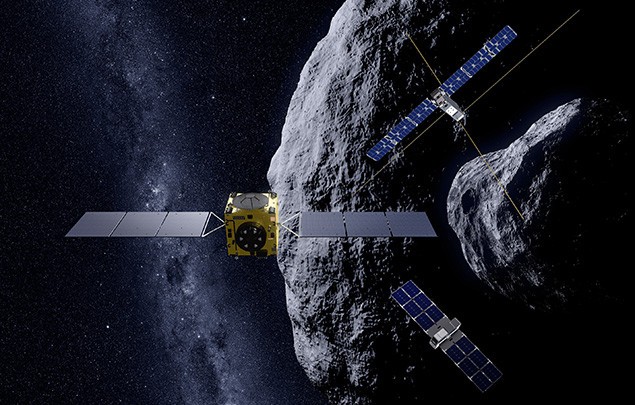HERA takes its turn after DART

On September 27th, at 1:14 AM CEST, the USA’s Double Asteroid Redirection Test (DART) probe successfully collided with its target, which was the moon of the Didymos binary asteroid system. Known as Dimorphos, this is an asteroid with a diameter of about 160 meters, giving it a size similar to that of the Great Pyramid of Giza. This asteroid orbits the system’s main asteroid, known as Didymain, which has a diameter of about 780 meters.
NASA’s DART is the first planetary defense mission, and its primary objective is to test the kinetic impactor concept. Afterwards, HERA, the European component in this coordinated planetary defense, will carry out a detailed study of the consequences of this impact.
The impact with Dimorphos took place at almost 11 million kilometers from Earth, at a speed of 6.6 km/s. LICIACube, the CubeSat produced by the Italian Space Agency (ASI) separated from the DART probe 15 days prior to the impact. Its purpose was to record the collision and it has captured images of the resulting ejecta plume and impact crater.
Now it is HERA's turn. The European Space Agency's probe measures 2.2 x 2 x 1.8 meters and weighs less than a ton. It is equipped with large solar panels and a hydrazine propulsion system. HERA will be launched from an Ariane 6 at the end of 2024, and it will arrive at the Didymos binary asteroid system in 2026.
In November 2019, the HERA mission was approved by the European Space Agency (ESA) at its Space 19+ Ministerial Council. This allowed entry into the operational stage, which began with detailed definition and development performed in collaboration with industry participants from Germany, Belgium, Romania, Luxembourg, Portugal, Spain, the Czech Republic, Austria, Finland, Ireland and Switzerland. In September of this year, the process known as Critical Design Review (CDR) was initiated for the HERA mission.
HERA's objectives
The ESA is pursuing a twofold objective with HERA: to test key planetary defense technologies, such as autonomous navigation in proximity to a celestial body; and to perform a detailed study in order to characterize the binary system and its moon in particular, including detailed measurements focused on the results of the DART impact with Dimorphos. In this way, the ESA will be further advancing the field of planetary defense by obtaining important scientific information, especially in relation to asteroid modeling. This is information that will also improve our understanding of the origins of our solar system and the origins of other planetary systems as well.
HERA will also have two CubeSats on board, known as JUVENTAS and MILANI. These will be carrying instruments to perform scientific experiments, which will produce additional data and other valuable information to complement the information being sent back to Earth by HERA.
GMV’s role in HERA
The multinational technology firm GMV leads an international industry consortium with participants from Spain, Portugal, Romania, France, Germany, the Netherlands and Ireland. This group is responsible for mission analysis and for designing and developing HERA’s guidance, navigation and control (GNC) system.
GMV has already developed an innovative autonomous GNC system, after taking into account the difficulties existing in relation to the approach and navigation operations. These include communication delays in deep space, the irregularities that characterize asteroids and the uncertainties associated with the unexplored deep space environment.
There are two factors that characterize this special GNC system developed for HERA. It has the ability to autonomously execute the flight plan defined by the team at the ground control center and its degree of autonomy can then be increased, so that the maneuvers needed to fly to a particular altitude can be calculated on board, or so that an escape maneuver can be executed if a collision risk arises.
In addition, GMV’s team in Romania has developed the mission analysis studies and GNC system for JUVENTAS. This is the nanosatellite responsible for measurements regarding Dimorphos’ gravitational field and internal structure. There will also be experiments performed on satellite-to-satellite radioscience and a low-frequency radar study on the asteroid to reveal information about its interior. Finally, there will be a landing on Dimorphos, with measurement of the forces produced during touchdown.